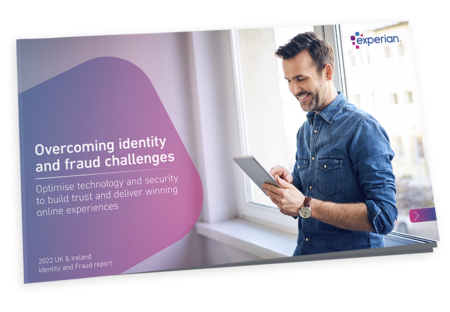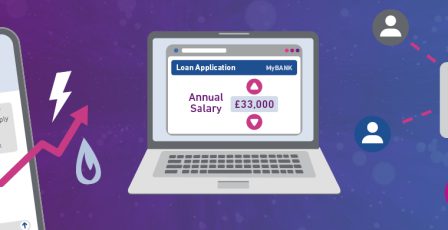The different types of fraud and how they’re changing
The rapid rise in digital activity has created new opportunities for fraudsters
The Covid-19 pandemic has accelerated demand for digital and online customer experiences. To keep pace, businesses have rapidly transformed their operations to accommodate new digital services and onboarding capabilities, while fulfilling consumer expectations for fast, easy and secure interactions.
However, the rapid rise in digital activity has created new opportunities for fraudsters, exposing businesses and consumers to increased risks of fraud, identity theft and data breaches.
In this blog, we’ll be exploring the key types of fraud, how and why they’re changing, and what lenders can do to protect themselves and their customers. Firstly, let’s look at the three key types of fraud:
What is first-party fraud?
What is first-party fraud?
First-party fraud is where a person knowingly misrepresents their identity or gives false information for financial or material gain.
First-party fraud is where a person knowingly misrepresents their identity or gives false information for financial or material gain. For example, by exaggerating their income, fabricating their employment or misrepresenting their financial circumstances to get services..
First-party fraud is often miscategorised as credit loss and written off as bad debt. This causes problems when businesses later try to determine how much they’ve lost to Smaller text supplying further fraud versus credit risk, and then make future lending decisions.
What are the common types of first-party fraud?
- Fronting – setting up a service in someone else’s name to save money. For example, a young driver obtaining cheaper car insurance, by applying under their parent’s name and nominating themselves as a named driver.
- Address Fronting – using a different risk address for an application (either one owned by the individual or an unrelated address) to reduce the cost of a service. For example, taking out a car insurance policy at a holiday cottage rather than a main home address
- Chargeback fraud – sometimes referred to as “friendly fraud” or for the gambling industry “gambler’s regret”. This is where an individual denies buying an item on a credit or debit card, to get a refund from the card provider.
- De-shopping – buying items such as clothes with the intention of using them before returning them for a full refund.
- Goods Lost in Transit Fraud (GLIT) – ordering goods online and falsely claiming that they haven’t been delivered, have been damaged or even returning empty boxes to get a refund
How has first-party fraud changed?
The typical profile of first-party fraudsters has changed significantly during the pandemic. Previously customers with a respectable credit rating and history of repayment have found themselves struggling financially. This change in circumstances could lead to changing behaviours.
The recent CIFAS report[1] states that:
‘1 in 13 Brits admit to committing at least one form of first-party fraud in the last year, with those 16-34 the most likely to do so’.
CIFAS report
With this changing risk profile, it’s vital to keep reviewing your existing customer risk profiles. Not just at the application stage, but throughout the customer journey.
What is second-party fraud?
Second:-party fraud is where an individual knowingly gives their identity or personal information to another person, to commit fraud. One of the most common types of second:-party fraud is money muling. An individual allows someone else to use their bank account to transfer money in and out, in exchange for a small fee. Far from being a “victimless” crime, the money being moved is often the result of criminal activity or money laundering and can be used to fund terrorism, exploitation and violent crime.
How has second-party fraud changed?
Traditionally, young and vulnerable people have been the target of second-party fraud. Social media has been used heavily to target the young and vulnerable in this way. Currently, banks are seeing more of their older customers involved. As with first-party fraud, the pandemic has pushed more people into financial difficulties, making them more vulnerable to fraudsters.
Businesses can find it hard to detect and challenge first and second-party fraud. In both cases, the person whose identity is being used to commit fraud has knowingly allowed it to take place. Without the usual traces or behavioural characteristics associated with fraud, it’s difficult to spot. The person may also refuse to admit they were involved, making it tricky for businesses to prove without firm evidence. To help, we’ve developed predictive models, geo-demographic profiles and fraud rules that can help to identify the signs and prevent second-party fraud.
What is third party fraud?
Third-party fraud, generally known as identity theft, is where an individual’s identity or personal details are used without their consent or knowledge, to gain credit or products. It also includes manufactured identities, with the fraudster creating a new identity using stolen and false information.
Third-party fraud has a clear victim, so it can be easier to spot in your portfolios. It involves a person’s identity or personal details being used without their consent or knowledge, to gain credit or products. It also includes manufactured identities, with the fraudster creating a new identity using stolen and false information. Third-party fraud is the UK and across the globe.
How has third-party fraud changed?
Fraud varies significantly across lenders’ portfolios and product types, as well as across age, gender, geography and demographics. Our Fraud Index Report shows that third-party fraud is a growing risk for current accounts, as well as loans, cards and savings. In contrast, mortgages and asset finance are much more at risk of first-party fraud.
The fraud problem is complex. However, with a partner like Experian, you have the tools required to perform a closer examination and the ability to differentiate between the types of fraud so you can determine the best course of action moving forward.
How can lenders keep up?
The challenge for lenders is staying one step ahead in such a rapidly changing, digitally-led world, There is no one-size-fits-all solution. We can provide you with the fraud prevention tools to risk assess each piece of the identity jigsaw.
Our fraud and identity solutions, delivered through our CrossCore platform, deliver a future-proof, fully-customisable way to modify your digital identity strategies quickly, identify fraud faster, improve compliance, and enhance the customer experience. Giving you a seamless way to complete all the checks needed to protect your business and your customers, optimise results via analytics and adapt your approach as the external landscape changes. Whether you have a thousand customers or more than a million we have a solution for you.
How can we help?
Digital fraud is on the rise. During 2020, the value of loan and mortgage fraud increased by 675% to over £75 million, while unauthorised financial fraud losses across payment cards totalled £574.2 million. But it doesn’t have to happen to you.
Experian has the expertise to help you spot all types of fraud from false credit applications to account takeover attempts.
[1] First party fraud research, Cifas










